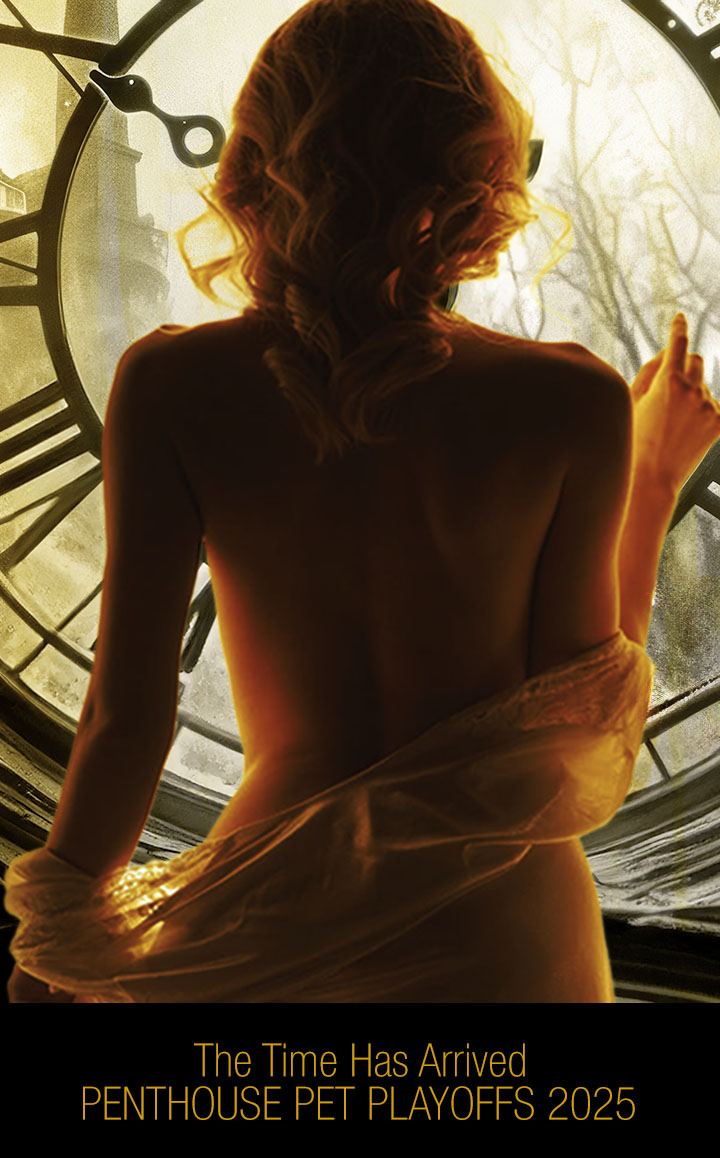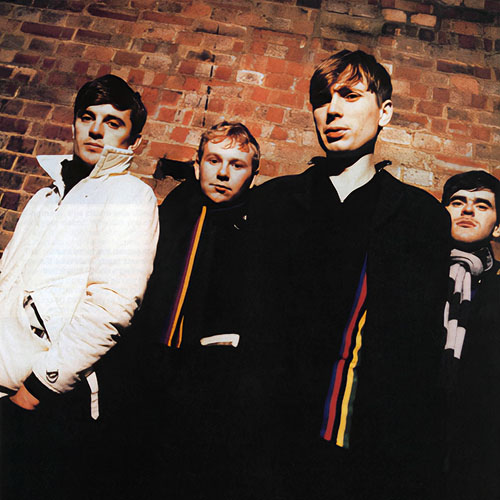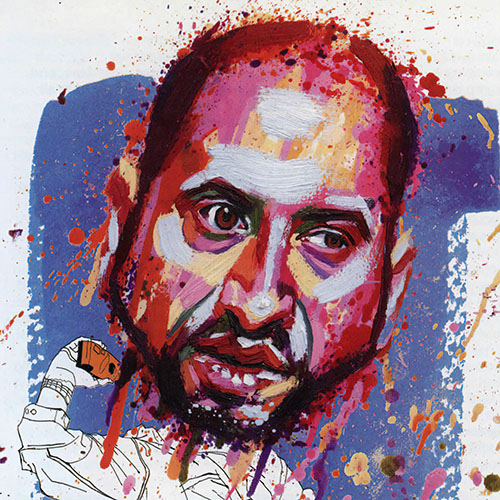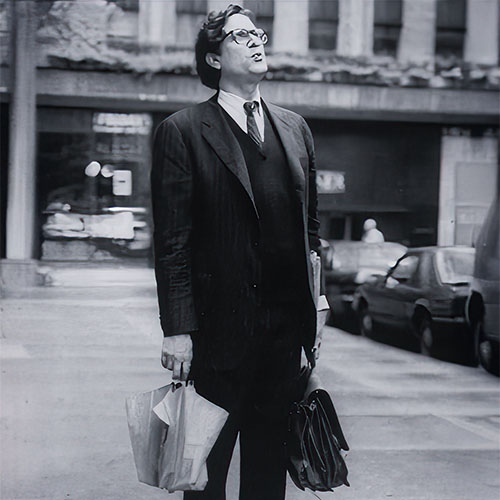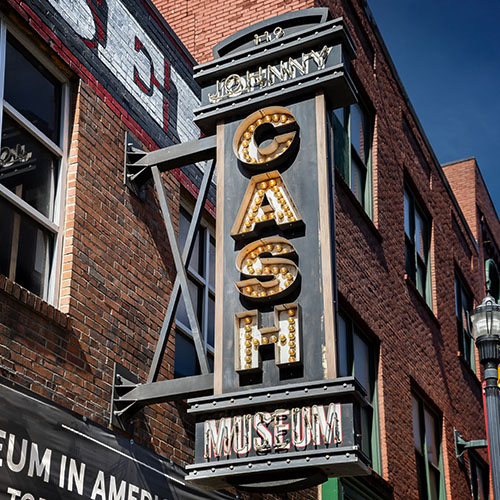But to Jose Luis Vega and perhaps a million other kids — the ever-growing heavy metal horde — Boy George was anathema, an abomination unto the Almighty Testosterone Din on High.
Feeling The Heavy Metal Noize
Heavy metal is a gaudy hash of sexism, Fascism, sadism, and Satanism. Some call it noise. Millions of fans call it rock and roll.
Boy George, the sweet-voiced, androgynous leader of the British band Culture Club, was then well on his way to becoming one of the darlings of rock and roll. His group’s new record, “Karma Chameleon,” would soon become the biggest hit in the United States. Mellifluous and reggae-flavored, its sound was pleasantly flighty. So was Boy George, profiled in September’s Penthouse, whose eccentric blurring of his sex was generally considered cute rather than offensive. Appearing on the cover of Newsweek, bantering with Joan Rivers on The Tonight Show, he was winning the hearts of America as surely as he had won the hearts of punkettes on the other side of the Atlantic
The first person I wanna kill is Boy George,” said Jose Luis Vega, nodding and grinning with dark delight.
Jose is 18 years old and lives with his parents and brothers in an apartment on West 44th Street, in the Hell’s Kitchen section of New York City, where he was born and raised. He discovered heavy metal music five years ago, when he was a student at the High School of Art and Design. His life since then has revolved around it, much to the exasperation of those in his household. “I have a twin brother who’s into mainstream rock. My older brother likes disco. My father listens to Latin music,” he explained. “They just sort of block me out from the entire family.” He does not smoke, drink, or take drugs. But he is addicted to heavy metal, and his job as an electrician’s apprentice supports his habit, which often costs him $100 or more a week in records and concert tickets.
“That’s nothing,” he assured me. “I’ve seen kids spend over $400 at a time.” As he sees it, there is no possibility that he would ever forsake heavy metal later in life. “I’ll die with this stuff,” he affirmed with all the conviction of one who had truly been born again in metal.
Rock and roll reflects the spirit of teenage rebellion. That is a terrifically trite and tired axiom; but it is also terrifically true. Rock and roll — the best rock and roll, in any case — is a celebration of sex, freedom, and debauchery by those who have just begun to discover those things. Only the innocent can revel in wickedness with such ardent, unflagging energy.
Since its ascension 30 years ago (and it was exactly 30 years ago this summer that Elvis Presley made his first records), every generation of rock and rollers has been damned by the generation that preceded it. Elvis, Jerry Lee, and the other founding punks of the fifties were denounced by adults who grew up with big-band swing. The Beatles, the Rolling Stones, and the rest were abhorred in the sixties by those who were the rockers of the fifties. The new-wave groups of the seventies were ridiculed by those who swore their Day-Glo souls to rock and roll ten years before. It is inevitable that each succeeding surge of rock and roll should alienate and offend the rockers who came before it. If it did not, it would not be rock and roll. Yesterday’s kids must be assaulted by the kids of today; the kids of today must be condemned as mindless, tasteless, hopeless punks by the mindless, tasteless, hopeless punks of yesterday. This, as much as music, is what rock and roll is all about.
The heavy metal kids of today, Jose’s age and younger, were barely marijuana twinkles in their parents’ eyes when the noise of The Who’s “My Generation” rose in loud defiance nearly 20 years ago. Many of them, swaddled in patchouli-scented linen, were born between the so-called Summer of Love and the Woodstock Festival, when it seemed for a long innocent moment that rock and roll was more than a business or an entertainment, that it was somehow more revolutionary, more meaningful than the champagne music of Lawrence Welk. Now The Who’s generation is pushing 40, or dead, and those who once peopled Woodstock Nation now inhabit Co-op Nation; they are balding and more concerned with tax-exempt-bond funds than with revolution. They listen to records by middle-aged singers like Mick Jagger and Bob Dylan; perhaps they tap their feet to the younger infectious sounds of Michael Jackson and Boy George. Heavy metal, however, is something they can neither understand nor accept. They say that it is offensive and obscene, it is too loud, and it all sounds the same. In other words, they accuse it of being everything that their music was accused of being 20 years ago. The ungracefully aging rock-critic establishment, a superfluous media accretion that did not exist 20 years ago, has been almost unanimous in its angry condemnation of heavy metal. One critic, typically, described it as “songs that only someone who’s just discovered jerking off could love.” As if “She loves you, yeah, yeah, yeah” had been the stuff of deep-seasoned souls! Indeed, how soon they forget. David Lee Roth, the lead singer of Van Halen, one of the biggest heavy metal acts, has succinctly said, “The reason so many critics dislike Van Halen and like Elvis Costello is because they all look like Elvis Costello.” Impolite words, perhaps, but their point is true.
‘“I don’t like to use the words ‘heavy metal,’” says Ozzy Osbourne. “I call it ‘heavy rock.’ It doesn’t fuck around.”’
It is to heavy metal’s credit, of course, that all the accusations leveled against it are somewhat right. Deafeningly loud, unregenerately trashy, and all-offensive, it is the most vehemently damned music in the history of rock and roll; this is its crowning glory.
HEAVY METAL, METAL ÜBER ALLES
It is hard to say whether outsiders are more repelled by heavy metal’s thunderous volume or by its trappings — a gaudy hash of sexism, Fascism, sadism, and Satanism. Heavy metal is a distinctly male phenomenon. There are a few rare female heavy metal acts — Girlschool from England, Cheetah from Australia, and former Runaway Lita Ford (none of them very successful) — and when members of the fair sex attend heavy metal concerts it is usually as the reluctant date of a more enthusiastic boyfriend. David Lee Roth of Van Halen stands out as the only real heavy metal cunt-throb. As one record-company executive told me, “Girls really aren’t interested in this stuff. They wanna fuck Boy George. Of course, he’d rather fuck his drummer; but that’s rock and roll for you, I guess.” Serving less to wet the Brazilian-cut panties of pubescent girls than to exalt the spurned, unspendable sexuality of working-class boys, the heavy metal idols with their bolstered and bulging crotches are priapic lightning rods, transforming the energy of sexual frustration into dazzling sight and furious sound.
Chaste and trifling genitals become mighty ordnance of raging liberation. “Oh, I got big balls, I got big balls,” shouted Bon Scott, the lead singer of AC/DC. Though Scott departed for the heavy metal hereafter, having choked to death on his own drunken puke in 1980, AC/DC’s “Big Balls” remains one of the music’s anthems, sort of a heavy metal “My Way.”
“We’re the American youth,” said 25-year-old Nikki Sixx, the bass player in Motley Crue, the Los Angeles heavy metal band whose layered shags, makeup, and high-heeled platform boots take up where Kiss left off. “And youth is about sex, drugs, pizza, and more sex. We’re intellectuals on a crotch level.” Sixx claims that on “Ten Seconds of Love” — one of the recordings on Motley Crue’s 1983 album, Shout at the Devil — he can be heard practicing what he preaches. “If you listen very closely,” he maintained, “you can hear a lot of squishy sounds during that song. That’s because we were fucking some chicks while we were making the record. Now when they’re playing that song at home, they can tell all their friends, ‘Hear that noise? That’s me being fucked by Nikki Sixx.’” Then again, he also claims that Nikki Sixx is his real name.
To the minds of many heavy metal fanatics, guys such as Sixx are as romantically old-fashioned as a lace valentine, as passe as their parents’ free love and sex without guilt. Hardcore heavy metal goes far beyond the traditional wet-dream fantasies of rock and roll.
My pulse is beatin’ stronger,
Can’t take it any longer —
Women in chains!
Women in chains!
Women in chains!
This, the refrain of “Women in Chains” by the British group Waysted, is indicative of heavy metal’s deeper romantic yearnings. (It also, I think, helps to explain why young girls are less than plentiful among the heavy metal ranks.) “Women in Chains” goes on to recall a certain Alice, who is remembered with sardonic fondness as “sucking and sucking and sucking.” Vices, the 1983 Waysted album that included the song, featured on its cover, yes, a woman in chains.
White Lace and Black Leather is what the Canadian band Helix called one of its albums. A subsequent single celebrated a “Heavy Metal Love” in “leather and lace.” The British group Judas Priest, whose fifth album was named Hell Bent for Leather, performs material such as “(Take These) Chains” and “Pain and Pleasure.” The latest heavy metal band from Germany, Accept, sings of “London Leatherboys” in their first American album, Balls to the Wall (the cover of which unintentionally outdoes anything the Village People ever dared: a black-and-white photo of a hairy thigh, a glimpse of male crotch in a bikini brief, and a leather-sleeved arm, its hand clutching — roll over, Bon Scott — a big ball). Van Halen’s 1982 platinum album, Diver Down, included a poster of David Lee Roth in chains, photographed by none other than Helmut Newton. (Perhaps this helps to explain why young girls are plentiful among the ranks of Van Halen’s fans.) Van Halen is also responsible for the ultimate S & M rock video — their production of “Pretty Woman,” which featured not only high-heeled cuties in bondage but transvestites and evil midgets as well.
Curiously, all of these acts disclaim the S & M images they project. Judas Priest’s Rob Halford strikes what is perhaps the most extreme pose in heavy metal. His appearance is nothing less than that of a garish S & M Liberace: black-leather boots, jodhpurs, vest, and cap; spiked and studded collar, armbands, gloves, and greaves; clanking chains and gleaming zippers. But Halford maintains that it is all for show. “Before I started wearing this stuff,” he said, “I didn’t really realize that it was so deep.” He has “come up against quite a few weirdos” who, intrigued by his costume, have attempted to involve him in some rather bizarre goings-on; but, nice Walsall lad that he really seems to be, Halford refuses to take his own mummery seriously, and for him it remains little more than “a good strong image,” a masquerade. “The black-leather thing just feels right with the music and the general thing we’re putting across.”
Lunge to the maximum,
Spread-eagled to the wall,
You’re well-equipped to take it all.
Yes, one might agree that black leather does indeed go well with lyrics such as these, from Judas Priest’s “Eat Me Alive,” and with other aspects of the band’s “general thing” — such as Halford whipping kids in the front rows during performances of a song called “Fire and Genocide.” (Again, Halford disclaims. “I wasn’t actually whipping them,” he averred. “God, no. If I was, I’d be in jail for G.B.H. [Gross Bodily Harm], wouldn’t I? No, like I say, it was just a pure theatrical extension of the musical and lyrical content of ‘Genocide.’”)
“Fire and Genocide” is one of the Sturm und Orang crowd-stirrers that especially incense outsiders. More than a decade ago, the Blue Oyster Cult placed a nonsensical Germanic umlaut over a vowel in their name, adopted a symbol — a stylized, overturned ankh set in a circle — that was slyly remindful of Hitler’s modified swastika emblem, and began to make albums with titles such as Tyranny and Mutation, Secret Treaties, and On Your Feet or on Your Knees. Since then, heavy metal has been rife with crypto-fascist overtones, from the fairy-tale Aryanism of songs such as Saxon’s “Warrior” to the metal militarism of Judas Priest’s recent “Heavy Duty”:
Let’s all join forces,
Rule with an iron hand,
And prove to all the world
Metal rules the land.
Heavy metal acts know what Hitler and Mel Brooks knew before them: Audiences love Nazis. One night last January, I sat in Radio City Music Hall waiting for the Blue Oyster Cult to come onstage. The crowd was young — except for a few conspicuously older Cult diehards, their eyes still glazed from the long, dull haul of the seventies — and restless. “Fuck you, Louie!” one kid shouted. “Fuck you,” Louie shouted back. “I mean it, Louie. You fuckin’ suck.” And so on. Some things, I reflected, never change. Three girls, even more conspicuous in their presence than the handful of 30-year-old geezers from the olden days, strolled down the aisle and were quickly surrounded by a dozen or so heavy metal boys in leather jackets and T-shirts. (As at most such gatherings, leather jackets and T-shirts are de rigueur. Each T-shirt bears the logo of the wearer’s favorite band.) The girls wove smoothly through the boys’ snare. One of the boys lit a firecracker and threw it after them. The girls clapped their hands to their ears and screamed; and the boys were satisfied. “That was fuckin’ good,” one of them smiled. “Yeah,” the one who had tossed the firecracker said. Up the aisle came a pair of usherettes in brown skirts and pumps, dragging a boy — 15 years old at most — who was foaming at the mouth and kicking his feet. The looks on the usherettes’ soft faces betrayed a longing for the calmer, bygone days of the Rockettes. Finally, the lights dimmed, and Blue Oyster Cult took the stage. The crowd went wild, then quieted. Behind the band a curtain rose, revealing two large banners emblazoned with the red-on-white Cult symbol. Thousands of kids jumped up in fast, excited salute, raising their arms and pointing their fingers upward in regimented frenzy. The guitarist Donald Roeser struck the first doom-blasting chord of “Cities on Flame with Rock and Roll.” It literally shook the seats and caused the floor to quake; and the audience drowned it in rapt cheering.
Looking about, I let myself wonder (a rare treat these days) if Hitler Youth rallies had been at all like this — an analogy commonly conjured up by heavy metal’s denouncers. Of course not; the comparison is a ridiculous one. I remembered that my old friend Sandy Pearlman, who as Blue Oyster Cult’s manager had concocted the group’s controversial image, was really a nice Jewish boy from Smithtown, Long Island, who listened to classical music and took more vitamins than anyone else I have ever known. “I’m not in business to make sense” is what he used to say.
As for the kids themselves, many of them are not even truly aware of what Nazism is. When I questioned Jose about the swastika flag that hangs with the heavy metal posters on one wall of his room, he said, “Don’t get the wrong idea. I’m no Communist.” Disdaining what Jose calls “political hogwash,” the heavy metal kids embrace Nazi regalia only for shock value not for any ideological reasons. Swastikas serve much the same purpose that peace symbols did in the late sixties: to upset adults. What little they know about the Third Reich is based on reruns of Hogan’s Heroes and movies like Raiders of the Lost Ark.
The same is true of the music’s “devil worship,” which has so aroused the wrath of publicity-hungry Christian groups. From the pentagrams used by Black Sabbath and Motley Crue to songs like Iron Maiden’s “The Number of the Beast” and Judas Priest’s “Devil’s Child” (“You cut my flesh/ And drank my blood that poured in streams”), the Satanism that pervades heavy metal is mostly gibberish lifted from horror movies. (Heavy metal kids are not usually literary enthusiasts. Most of those I spoke with seemed to regard my occupation as an arcane and antiquated one — not that I could wholeheartedly disagree with them. Jose told me that he enjoyed reading — “I like to read about very old things. I read a book on John F. Kennedy, ya’ know?” — but he was unable to recall the title of any book he had read.) Black Sabbath, the fathers of heavy metal Satanism, took their name from a 1964 Italian movie starring Boris Karloff. Iron Maiden’s bass player, Steve Harris, was inspired to write “The Number of the Beast,” not by Revelation 13: 18 but by Damien — Omen. II. As for Motley Crue’s pentagram symbols, which they swiped from Black Sabbath (these guys will steal anything that’s not nailed down — umlauts, platform boots, magical configurations), the group doesn’t seem to have bothered to find out what a pentagram actually is. Vince Neil, the band’s lead singer, elucidated, “It wards off werewolves. If you wear a pentagram and a werewolf’s around, he won’t fuck with you.” So much for Aleister Crowley.
While ministers rail and protest against the purported Satanism of heavy metal, insiders take it far less seriously. “Ah, the devil-worship bit,” said Iron Maiden’s vocalist, Bruce Dickinson. “We’re not angels. We don’t go to church every Sunday. On the other hand, we don’t spend time messing around worshipping the devil. The funny thing is, the fans know that. None of the fans think we’re devil-worshippers. They think it’s a real laugh.”
What heavy metal fans do take quite seriously are the shows they pay to see. As Jose put it, “Without stage shows, there’s nothin’. I don’t consider a group a group without a stage show.” Knowing that the sound of heavy metal is in some ways secondary to the spectacle of it, bands spare few expenses on their unending quests for bigger and better shows. Lasers and fireworks are already old hat. Iron Maiden performs beneath an immense inflated brain and shares the stage with a giant monster called Eddie. On a recent tour, Judas Priest employed a huge, multilevel stage incorporating hundreds of lights and assorted hydraulic and pyrotechnic contraptions. At the close of every show, Rob Halford returned to the stage for his encore on a Harley-Davidson low-rider. Blue Oyster Cult’s latest shows feature the eerie billowings of a fog machine and the sudden appearance of an extravagant model dinosaur. From the simplest flash-pot to the most sophisticated technical marvel, these special effects elicit from their audiences the plain and open oohs and ahs of kids who have never been to the circus before. For them, heavy metal is a circus. Women in chains! Gladiators from hell! Monsters and mayhem! And enough thunder and lightning to scare away every teacher, mother, minister, and over-the-hill rock critic within hearing range. It is wicked wonderment’s last stand, the grand illusion at midnight.
Heavy metal fans are the same kids who made George Lucas a wealthy man. They are a little older now. Their Jedi swords have ceased to glow. The Force will not save them from a lifetime of assembly-line attrition; and, as it turns out, Princess Leia would rather fuck Boy George anyway. Heavy metal is the end of the fantasy, the final conflagration in which Luke Skywalker sees the light of evil, ravages the princess, and destroys the world, before joining the union and settling down to a beer and the six o’clock news.
THUS SPAKE OZZY
If there is a high priest of heavy metal, it is John Michael Osbourne, better known as Ozzy.
Though Led Zeppelin (the cataclysmically loud British band formed by guitarist Jimmy Page after the dissolution of the Yardbirds in 1968) are often credited as the prototypical heavy metal group, they are undeniably sophisticated musicians with backgrounds, however hidden, in electric blues. It was the group Black Sabbath, made up of four Birmingham boys in their young twenties, who took the great, drastic step away from bluesy roots to all-out lurid assault. That was in 1970, before the phrase “heavy metal” had begun to be heard.
(Actually, the term is an old one.) In Webster’s 1828 American Dictionary of the English Language, it is said to signify “large guns, carrying balls of a large size, or” — shades of AC/DC lyrics to come — “it is applied to the large balls themselves.” In William Burroughs’s Naked Lunch, published in July 1959, the words were used to denote torture. Seven years later, the phrase was first used in rock and roll when Ed Sanders gave the name of Heavy metal Music to the Fugs’ New York song-publishing company. In Steppenwolf’s 1968 hit “Born to Be Wild,” John Kay sang about “heavy metal thunder.” By 1972 the writer-editor Lester Bangs was using the phrase “heavy metal” to describe Black Sabbath and their sort of music in his articles for Creem, a rock magazine. When Lester Bangs died ten years later, heavy metal lost its most eloquent and persuasive supporter.
On Black Sabbath’s first album, which was released in the summer of 1970, it was Ozzy Osbourne’s maniacal voice that went on to become the voice of heavy metal. Throughout the seventies, Ozzy and Sabbath ruled the metal heap. Drunk, drugged, and disorderly, Osbourne was easily the most infamous figure in all of rock and roll, as execrated as he was idolized. At the end of the decade, he quit Black Sabbath and went out on his own. In 1980, after signing a deal with Epic Records, Ozzy was introduced to the company’s executive staff at a meeting in Century City in Los Angeles. He threw them all into a state of pandemonium by pulling a live dove out of a bag and biting off its head. This incident created such a public stir that Ozzy has since been demonstrated against by humane societies and religious groups. The situation was not enhanced when, at a Des Moines concert in 1982, someone threw a dead bat onstage and Ozzy bit off its head. A series of painful rabies shots ensued, along with all sorts of outrageous rumors. It reached the point where alarmists were declaring that Ozzy sacrificed goats to Satan as part of his heavy metal show. In Odessa, Texas, a group called Odessans for Decency warned that Ozzy’s music encouraged the use of drugs and the practice of witchcraft. One decent Odessan said, “We’re not talking about rock and roll. We’re talking about a maniac!” Of course, none of this hurt Ozzy’s career. His 1982 album, Speak of the Devil, quickly went gold.
When I visited this elusive gentleman on the eve of his recent performance at Madison Square Garden in New York City, I found him to be quite more serene than the reputation that had preceded him. Ulcers, a new marriage, and a new child had put an end to his drug days and had considerably reduced his drinking. Chain-smoking cigarettes as he raked his mind for the right words, he was, I thought, the least conceited and most friendly rock-and-roll star I have ever encountered. I asked him if he had ever seen the movie Nightmare Alley. He said that he had not, and I told him about the movie — about how Tyrone Power played a geek who bit chickens’ heads off.
“Jesus, these people act like I invented it. I don’t think I’ll ever be allowed to get away from that. It would be nice to be remembered for making 17 LPs that have all gone gold. But, inevitably, it’s gonna be: Ozzy Osbourne, the guy who bit the head off a bat.
“I don’t deny it happened. I just wish that people would just get on with it. In all those bizarre situations, I’ve always been three-parts drunk. It just happened, that’s all. I mean, I like animals.
“It’s my own fault. I’ve let people think I’m a fuckin’ madman. If I’m not fuckin’ screaming or diving through windows or throwing glasses at walls, people think I’m fuckin’ ill. If I sit in a bar and try to have a quiet drink by myself, people come up to me and ask me what’s wrong. I can’t complain about it because that’s the image I’ve put across to people. They think I’m a fuckin’ lunatic.
“The people that really kill me are the ones who think I really worship the fuckin’ devil. It’s only a theatrical role that we try to create. The whole thing’s just like going on a ghost ride at a fun fair. Vincent Price must have acted in hundreds of vampire roles, and he doesn’t get half the flak we do.”
I asked him how he defined heavy metal, and what sort of music he listened to as a kid.
“The first heavy thing that really hit me was ‘You Really Got Me’ by the Kinks, in 1964. I bought that record and played it to fuckin’ death!
“I don’t really like to use the words ‘heavy metal.’ I call it ‘heavy rock.’ It’s just the hardcore stuff: very loud, very aggressive. It doesn’t fuck around.
“Most parents don’t understand it. They think it’s all a big, loud excuse for kids to get out of it on drugs and booze. As a parent myself, I understand how they feel. In every crowd there are invariably a few assholes who start throwing around M-80s and that sort of thing. If a kid says, ‘Ma, I’m goin’ out to see Ozzy Osbourne,’ and he comes home on a stretcher with his eye blown out, the parent’s gonna think, ‘What the fuck’s this guy all about?’ They’re not gonna blame the asshole in the crowd; they’re gonna blame me, because it was my concert.”
I asked him about the tattoos on his arms and chest. Did they come with any stories, as tattoos often do?
“No, I just like tattoos.” He indicated the little stick man with a halo, the emblem of the fictional saint etched between his left thumb and forefinger. “The guy who did this one is most likely still in jail. He killed three prostitutes.”
“What were you in jail for?”
“Fucking up. Stealing shit.”
“How seriously do you take yourself as a singer?”
“I’m not a great singer. I’m a show-off. If I were a really great singer, I wouldn’t be singin’ rock and roll, I’d be singin’ grand opera.”
“Do you still enjoy performing, or is it getting to be a bore?”
“Rock and roll is a good living for me. It’s made me a wealthier man than I was before. Plus the fact that I really get a kick out of it.
“Lately, though, I’ve been wondering whether or not there’s a limit to how far you can go with all this. Lasers, holograms. What else can you do? Once you’ve seen it, you’ve fuckin’ seen it, ya know? It’s like Kiss. They went as far as they could go — then pft.
“I could have gone on this tour with a minimum show. But the kids would’ve gone away disappointed, and they wouldn’t come back next time. ‘Oh, fuck him’ ya know?
“The current show I have got — this vast haunted-house thing — cost me $500,000. Half a million fuckin’ dollars. That means for the first three months of the tour, I’m just making back what I laid out for the stage show.”
“How much will you clear tonight at the Garden?”
“I couldn’t begin to tell you. I really don’t know. The Garden is just a prestige gig, that’s why people play it. Unions there are just totally outrageous — coffee breaks every hour — and if you go into overtime, forget about it. I think it’s costing us $60,000 to rent the place for tonight. I might come out with 15 grand at the end of the night. Then I’ve got to pay everybody. I’ve got 52 guys on the crew. And these fuckin’ hotels in New York City are a real joke. The room I’ve got at the Parker Meridien is $450 a day y’know. I was gonna try the Helmsley Palace for a change, but they wanted $800 a fuckin’ day.”
“How have your ears held up through all this?”
“The last time I went to the ear doctor, he told me I had the hearing of a fifty-year-old man.”
ALL THAT’S HEAVY METAL GOLD
The horde increases, and heavy metal’s dominion over rock and roll grows greater. Last year there was a million-selling single — Quiet Riot’s “Cum on Feel the Noize” — and, while Culture Club’s “Karma Chameleon” made it to No. 1 on Billboard’s Hot 100 earlier this year, Van Halen’s “Jump,” Motley Crue’s “Looks That Kill,” and Quiet Riot’s “Bang Your Head” eventually overtook it. Iron Maiden’s Piece of Mind and The Number of the Beast, Def Leppard’s On Through the Night, Quiet Riot’s Cum on Feel the Noize, and Judas Priest’s Defenders of the Faith have all gone gold; Def Leppard’s Pyromania and High ‘n’ Dry, Quiet Riot’s Metal Health, Judas Priest’s Screaming for Vengeance, and Van Halen’s first and most recent albums, Van Halen (still on the charts after three years) and 1984, have been declared platinum. The biggest heavy metal groups — Van Halen, Judas Priest, and a few others — are now scoring concert grosses of a quarter of a million dollars and more; AC/DC singing “Big Balls” has come within 3,000 tickets of beating the Meadowlands attendance record set by Frank Sinatra singing “My Way.”
But sales do not end with records and concert tickets. Heavy metal albums include merchandise catalogs offering everything from Iron Maiden wallets and key chains to Judas Priest sleeveless T-shirts and leather wristbands. Never before has rock-and-roll capitalism triumphed as gloriously in the mass marketing of imagery.
From here on in, it’s just a matter of waiting for the heavy metal rendition of the national anthem one cold Superbowl Sunday. Then we will know that the next wave of hopeless, mindless, tasteless punks is fomenting to rescue middle-aged America once again from the languor of easy liberalism.
TURN IT UP
While I last spoke to Jose, I asked him about the future of heavy metal. “It will be louder,” he said after brief deliberation. Then, giving me a better ending for these paragraphs than any I had hoped to wring from metaphors alone, he told me that he had enlisted in the marines, which he figured was the heavy metal branch of the armed forces. Let us sleep well then, gentle readers, secure in the knowledge that creeping Boy Georgeism has met its match in Jose.
A surprising amount of knowledge — at least as evidenced by the youngsters in the other office chairs — sprung immediately to mind to offer up as icing on the Legacy cake. Looking at articles four decades old can be great fun, particularly if you lived through that era. We may not all understand why someone truly believe a “story” fits within the parameters of a social media site, but then attention spans have become a different thing over those forty years. We really should come up with a better term, as “span” does not seem particularly accurate anymore. More like a blip, really. Suffice it for our purposes here to point out that “Heavy Metal” used to be a real magazine (and now we need to go explain what “magazine” means). For the record, odds seem very good that at least one of us will walk into the office for a few days singing, “Out there is a fortune, waiting to be had.”







